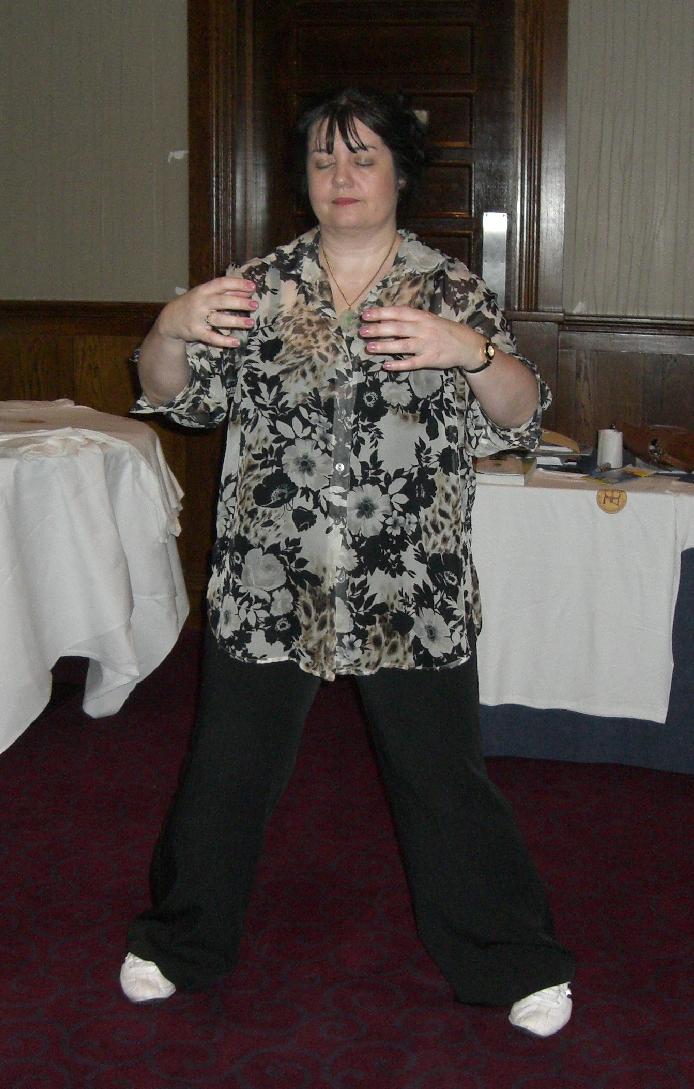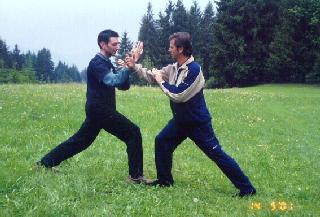IS THERE FURTHER TRAINING AFTER AN INTENSIVE COURSE?

Sifu Joan Browne performing the Three-Circle Stance
If they diligently practice only what they have learnt from me in the three- or five-day courses, they will become real masters in three years! -- Grandmaster Wong Kiew Kit
Question
Even if he or she practices what was taught in the course, there will be no fresh input. The martial arts of Shaolin and Taiji are so rich and vast that surely 5 days would not be enough to give more than a sample. How would an eager student learn more? From your website, it seems you have only 3 courses. Kaiwan, Singapore
Answer
I often tell students to my intensive courses that if they diligently practice only what they have learnt from me in the three- or five-day courses, they will become real masters in three years! This is mentioned not to gain vainglory but to motivate them. And it has proven to be true.For example, Joan from Ireland attended my Intensive Chi Kung Course to overcome a back problem that Western doctors said she had to live with for life. Now she is an excellent chi kung instructor and has helped many students overcome so-called incurable diseases.
Javier from Spain attended my Intensive Taijiquan Course to find out about chi and combat application, which he had no idea before although he had practiced Taijiquan for many years. Now he is a Wahnam Taijiquan instructor helping his students to enjoy chi flow and inner peace.All of these Shaolin Wahnam instructors started teaching, with my blessings, about three years after attending my intensive courses.
I also often remind my students that compared to what is in store for us in genuine chi kung, Shaolin Kungfu and Taijiquan, what we have achieved, including myself, is only a very small part of the potential. The ultimate achievement of all these arts is the highest spiritual fulfillment, the greatest achievement any being can ever attain, called variously as Enlightenment, Emerging with Tao, or Return to God. We are all very clear about this supreme potential when we are ready — it is not just mentioned for fun or fashion.
There are a lot of opportunities for fresh input. For many students, attending an intensive course was the start of a rewarding relationship with and contribution to Shaolin Wahnam. Many return to repeat courses. Some have attended more courses, intensive as well as regional, than they can remember. Some have become Shaolin Wahnam instructors and give courses themselves.
While Shaolin Kungfu and Taijiquan as well as chi kung are exceedingly rich and deep, my three- or five-day intensive courses are sufficient to give a sample of these arts as comprehensive programmes for physical, emotional, mental and spiritual development. The intensive courses are also sufficient to let the students experience the outstanding characteristics of these arts, such as circulating and enhancing energy in chi kung, and internal force, combat efficiency and spiritual cultivation in Shaolin Kungfu and Taijiquan.
But it is never my intention to teach in these intensive courses the whole repertoires of these arts. In fact, these courses are only an introduction. In the Intensive Chi Kung Course, for example, students learn only three of the eighteen Shaolin Lohan Hands. The remaining Lohan Hands are taught by Shaolin Wahnam instructors in regional classes.
In the Intensive Shaolin Kungfu Course and Intensive Taijiquan Courses, students learn up to about Level 5 of our Basic Stage in our Shaolin Kungfu Training Programme and our Wahnam Taijiquan Training Programme. There are 12 levels in our Basic Stage. And there are 3 stages in our training programmes — Basic, Intermediate, and Advanced.
As the name tells, in the Basic Stage, students learn the basics, which are actually very important. Classical kungfu sets are taught only at the Intermediate Stage.
An interesting feature in our Shaolin Wahnam school, a feature many other people may find odd, is that soon our students — whether in chi kung, Shaolin Kungfu or Taijiquan — may not want to learn more! They soon discover that “less is more”! Some examples may make this feature clearer.
Our students discover from direct experience that they derive more benefits from practicing one chi kung exercise for 15 minutes than practicing three chi kung exercises for 45 minutes. Our Shaolin students discover that by flicking their fingers three times in a Sinew Metamorphosis exercise, they can develop more internal force than flicking their fingers forty nine times. Our Taijiquan students discover that by practicing only one pattern in Pushing Hands, they can be more skilful in combat than practicing ten patterns.

Sifu Javier Galve and Sifu Riccardo Puleo practicing Taijiquan Pushing Hands
Question We often hear of masters teaching their students most of the higher and secret arts, but keeping 10% of the best to themselves. I don't know if this is true, but looking at Aikido and the Yang-style Taiji, this seems to be plausible. Would you be willing to teach everything you know to your students?
Answer
There are no tailor-made answers to your questions. Different variables would affect the answers, and some of the important variables include the philosophy and personality of the masters, the abilities and character of the students, the nature and purpose of the teaching, as well as historical, cultural and environmental conditions.For example, if the master's repertoire is not large or if he is uncertain of the students' loyalty, he may keep 10% or more to himself.
In the past some masters kept some techniques to themselves for fear that their students might be better than they themselves and later betrayed them. But what is often not realized is that even if a student knows less techniques but if he trains diligently and becomes very skilful in the few techniques he knows, he can be better than his master who knows more techniques.
Hence, if he wants to keep some secrets, an intelligent master may teach the techniques but not the relevant skills. A crafty master may teach many techniques so that the students have no time to develop skills, giving the impression that they learn a lot but in reality they may not benefit much.
I am willing to teach my students all I know if they are ready and deserving. But teaching everything may not necessarily be for the students' best interest, and sometimes may actually be harmful.
Teachers come in different qualities. Mediocre teachers just teach and teach. Good teachers know what and when to teach. Excellent teachers know what not to teach. Bad teachers know not how to teach. And bogus teachers know not what they teach.

Grandmaster Wong and Sifu Jose Antonio engage in free sparring during an Intensive Taijiquan Course
Reproduced from Questions 4 and 5 in Selection of Questions and Answers — April 2004 Part 1
Please e mail your questions to Grandmaster Wong Kiew Kit stating your name, country and this webpage for reference. E mails without these particulars may not be answered.
